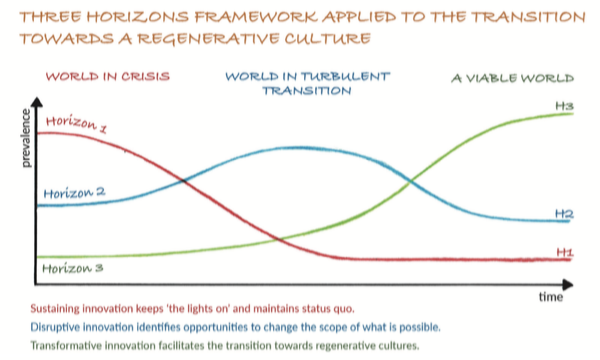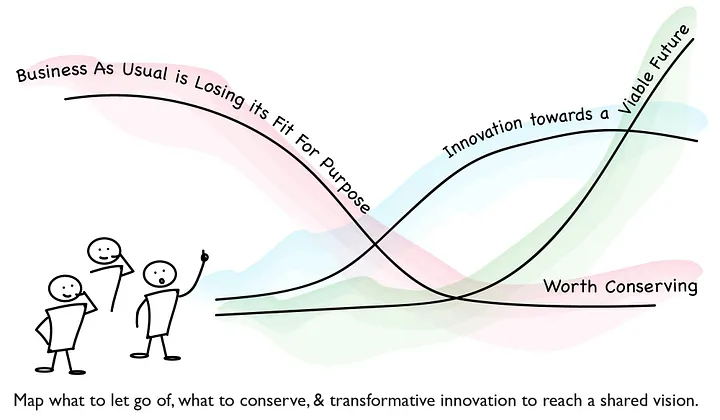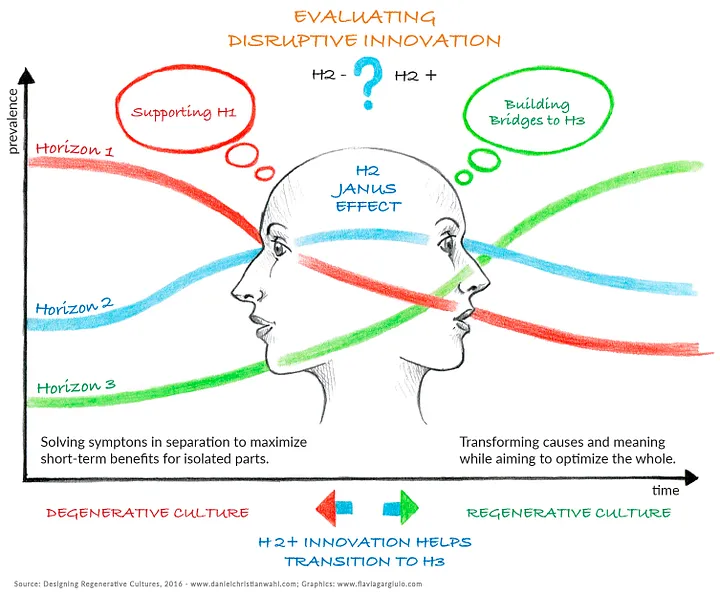What are the 3 Horizons of Transformative Innovation?
By Samuel Wines
4 July 2023

The Three Horizons Framework Adapted from IFF by Daniel Wahl
Transformative innovation, also known as disruptive or radical innovation, involves breakthrough developments that have the potential to fundamentally remake or redesign our current modes of production or create entirely new industries. This typology of innovation tends to phase-shift our current practices, processes or paradigms by replacing them with new ones that are grounded in bio-physical reality, creating significant advancements or efficiencies in the way we meet the needs of humanity whilst respecting planetary boundaries, raising social foundations for everyone, including the more-than-human world. Transformative innovation can take place in any field or industry, which is why we are a transdisciplinary innovation hub.
A useful mental model or way of framing this endeavour is the Three Horizons Framework, as popularised by the International Futures Forum. This model allows for the visualisation and management of innovation within an organisation, allowing for a more holistic view of innovation to be accounted for in the short, mid and long term.

Source: H3Uni
Below is an excerpt from the IFF website on the three horizons:
The first horizon – H1 – is the dominant system at present. It represents ‘business as usual’. We rely on these systems being stable and reliable. But as the world changes, so aspects of business as usual begin to feel out of place or no longer fit for purpose. Eventually, ‘business as usual’ will always be superseded by new patterns of activity.
The third horizon – H3 – emerges as the long-term successor to business as usual. It grows from fringe activity in the present that introduces completely new ways of doing things but which turn out to be much better fitted to the world that is emerging than the dominant H1 systems.
The second horizon – H2 – is a pattern of transition activities and innovations, people trying things out in response to the ways in which the landscape is changing. Some of these innovations will be absorbed into the H1 systems to improve them and to prolong their life (we call them ‘H2 minus’), while some will pave the way for the emergence of the radically different H3 systems (these we call ‘H2 plus’).
We typically introduce the horizons and think about the way the dynamic changes between them over time, in this order: H1 – H3 – H2. Because without a third horizon, it is impossible to make the distinction between ‘sustaining innovation’ (H2-) and ‘transformative innovation’ (H2+).
So with this framing, here’s our take on how we contextualise it to the realm of transdisciplinary innovation.
The First Horizon – Innovation as Usual: Today’s Dominant Pattern
Focuses on innovation that provides incremental improvements to existing products, services or processes – typically those that support ‘business as usual’ and generate the most amount of revenue. This perspective, often rooted in the narrative of separation, can be seen as sustaining innovation, a pattern or process that maintains the status quo, rooted in practices with a proven track record that extrapolates and projects a similar trajectory out into the future.
This H1 approach to innovation has, over the past 200 years, worked pretty well for humanity and, as a result, permeates into almost every aspect of our lives, especially into our organising patterns and behaviours, which have shaped our societal norms. However, even though this approach is ultimately unsustainable in the long term, Wahl notes that we shouldn’t ‘throw the baby out with the bathwater‘ as H1 innovations are foundational to the world as we know it, providing us with essential services (food, water, energy, education, and medicine), without which we would face the utter and absolute catastrophic collapse of our civilization as we know it, which, quite frankly, is not a vibe.
There is an inherent structural bias baked into the current ways of doing things (thanks to but not limited to concepts such as the sunk cost fallacy, game theoretic patterns and the law of increasing returns) versus cultivating the capacity to adapt to the emerging future. However, it’s worth noting that whilst sustaining business as usual may be beneficial in the short term – especially when coupled with continual economic growth – this mindset is a large part of why we are running up against planetary boundaries and will ultimately lead to self-termination of humanities great big civilisational experiment.
The Third Horizon – The Emerging Future
This horizon refers to the future topology of society, the new ways of doing things that will inevitably emerge as a result of dynamic, changing conditions, new knowledge, technology and innovation that facilitates the transition towards a more viable future. This last point, of working towards a more viable future, draws on the work of Daniel Wahl in his book Designing Regenerative Cultures. Wahl acknowledges that from an ecoliterate, living systems perspective, there is an inherent bias towards solutions that create conditions conducive to life and establish patterns of regeneration within H3 innovation.
Due to things like regulatory capture and the entrenched ways of doing and being in the world, this third horizon is, more often than not, avoided or actively worked against due to the momentum carried by the first horizon, which makes it difficult, if not downright impossible, to transition towards more viable pathways for our continued existence and collective thriving of the biosphere as a whole.
An important aside to note is that H3 innovation involves working with the unknown and uncertain. It requires us to be comfortable sitting in the ambiguity and not-knowingness needed to ensure that we can truly transition towards a circular, bio-based and regenerative economy. In addition to befriending uncertainty, innovators championing this third horizon must overcome infrastructural, social and cultural barriers that tend to obfuscate a clear pathway from ideation to actualisation for transformative innovation. Hence the need to understand complex systems.
Horizon 2 – Transitional Innovation
H2 innovation tends to have one eye fixed on the future, with the other eye looking back towards the past. It is the space of innovation that bridges the divide between the old and the new, striving to find a way that overcomes the limitations of H1 thinking whilst paving the path towards a resilient and regenerative H3 future. It is worthwhile noting that H2 innovation, for the most part, has a bias towards innovating in a way that is familiar to H1 innovation due to the fact that most of the money and resources are tied up within the traditional patterning of doing things, which have been successful at generating wealth over the last few hundred years. As a result, it is quite often the case that H2 innovation gets co-opted by H1, resulting in what could have potentially been a game-changing initiative being used to prolong or extend ‘business as usual’.
Moreover, for governments looking to support new ways of innovating, it can be difficult to create space for H2 to flourish. For example, even after a government supports fundamental research or a pilot program, the market selection dynamics are biased towards those existing incumbents that benefit from the rights and resources obtained from their H1 approach. As a result, these new ideas tend to be exploited by those with the underlying assumptions that business as usual must be maintained rather than questioning their raison d’être and modus operandi – in other words, what they are doing and why.
Bill Sharpe in his book, Three Horizons: The Patterning of Hope, explains how this phenomenon of H1 capturing and coopting H2 innovation is referred to as H2- behaviour and is, understandably, one of the major impediments to transformative change.

On the flip side, H2+ innovations are those that managed to avoid this retrograde trajectory and continue forwards towards the third horizon. Unfortunately, for those innovative ideas striving to hit escape velocity, they are forced to face the multiple valleys of death that await startups, scale-ups and even mature ventures that skirt the sides of the conventional basin of attraction. This is an inevitable part of an innovative organisation’s life cycle, especially for those working on transformative H3 innovation, which inevitably goes against the grain of conventional business.
The innovation that we endeavour to support at CoLabs falls within H2 to H3 innovation, with a focus on encouraging the development of H2 into the H2+ horizon.
Still trying to wrap your head around it all? Check out this awesome video from Kate Raworth, the author of Doughnut Economics as she explains the framework better than I ever could in seven minutes.
Tying it all Together
I know what you’re thinking. ‘Sam, enough with your highfalutin jargon and abstractions – give me a real-world example!‘ I hear you. So, to ground this abstract concept in reality, let’s take a quick dip into two examples that explore how the three horizons map to innovation in transportation and energy generation.
Example 1 – Transportation
Horizon 1 (H1) – Fossil Fuels
Traditional fossil fuel technologies, such as internal combustion engine vehicles, would be considered H1 innovations. These technologies are mature, widely adopted, and represent the status quo for most transportation needs. They generate the majority of the current revenue and profit for many companies in the automotive and energy sectors. H1 is about extending the life of these current technologies, improving efficiency, reducing costs, and defending existing markets.
Horizon 2 (H2) – Electric Cars
Electric vehicles (EVs) represent H2 innovations. Although they have been around for some time, they have recently become more mainstream. This is due to improvements in battery technology, reductions in cost, increased consumer awareness of environmental concerns, and changes in regulation that encourage or mandate the adoption of cleaner technologies. Many companies are investing heavily in EVs, and they are starting to contribute significant revenue. However, there is still much work to be done to fully replace internal combustion engines, particularly in terms of charging infrastructure and further reducing costs.
Horizon 3 (H3) – Hydrogen Fuel Cells
Hydrogen fuel cell technology represents H3 innovation. These are the potentially disruptive technologies of the future. While there are some hydrogen fuel cell vehicles in existence, the technology is not yet mainstream. Challenges such as the production, storage, and distribution of hydrogen fuel, as well as the cost and durability of the fuel cells themselves, must be overcome. But with the potential for vehicles that can be refuelled quickly, emit only water, and have a long-range, comparable with today’s fossil-fuel-dependent combustion engines. This technology has the potential to transform the automotive industry and our energy systems if these challenges can be solved.
In this way, the Three Horizons Framework helps to contextualise the shifts in energy and automotive industries over time, from the dominance of fossil fuels, through the emerging presence of electric cars, to the potential future role of hydrogen fuel cells. It helps guide strategic thinking about investment and innovation management in these rapidly evolving industries.
Example 2 – Fuel and Energy Generation
Certainly, here are some examples of H1, H2, and H3 innovations in the context of fuel and energy generation:
Horizon 1 (H1) – Coal and Natural Gas Power Plants
These traditional forms of energy generation are well-established and currently provide a significant portion of the world’s electricity. H1 innovation in this context might involve improvements in the efficiency of these power plants, the development of cleaner-burning techniques, or the implementation of carbon capture and storage technologies.
Horizon 2 (H2) – Solar and Wind Power
These renewable energy technologies are becoming more mainstream and widespread. The costs have significantly decreased over the years, making these technologies more competitive with traditional power generation methods. H2 innovation in this context might involve the development of more efficient solar panels, more durable wind turbines, better methods for integrating these power sources into the grid, or improved battery storage technologies to address intermittency issues.
Horizon 3 (H3) – Nuclear Fusion
Nuclear fusion represents a potentially transformative technology that could revolutionize the energy sector. Unlike nuclear fission, which is currently used in nuclear power plants and involves splitting atoms to release energy, fusion involves combining atoms. The technology promises to generate significant amounts of energy with very little waste and no carbon emissions. However, making fusion power commercially viable has proven to be a significant scientific and engineering challenge, despite many decades of research. If these challenges can be overcome, fusion has the potential to become a game-changing H3 innovation.
Each of these horizons requires a different strategic approach. H1 focuses on sustaining and extending current technology, H2 on scaling and growing emerging technologies, and H3 on exploring and pioneering future technologies. In each case, the goal is to provide cleaner, more sustainable energy.
Still Curious?
- Funding the Third Horizon
- Evaluating disruptive innovation in the age of transition – Daniel Wahl
- The Three Horizons of Innovation and culture change – Daniel Wahl
- Doughnut Economics Action Lab
- Swinburne University Centre for Transformative Innovation
- Griffith University Centre for Systems Innovation
- The Halogen Playbook for Systems Innovation
References
- Sharpe, B. Three Horizons: The Patterning of Hope. (Triarchy Press, 2020)